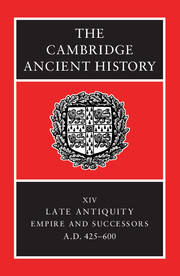Book contents
- Frontmatter
- PART I CHRONOLOGICAL OVERVIEW
- PART II GOVERNMENT AND INSTITUTIONS
- PART III EAST AND WEST: ECONOMY AND SOCIETY
- PART IV THE PROVINCES AND THE NON-ROMAN WORLD
- 18 The north-western provinces
- 19 Italy, A.D. 425–605
- 20 Vandal and Byzantine Africa
- 21a Asia Minor and Cyprus
- 21b Syria, Palestine and Mesopotamia
- 21c Egypt
- 22a The Sasanid monarchy
- 22b Armenia in the fifth and sixth century
- 22c The Arabs
- 23 The Balkans and Greece 420–602
- PART V RELIGION AND CULTURE
- Conclusion
- Chronological Table
- BIBLIOGRAPHY
- Index
- References
21c - Egypt
from PART IV - THE PROVINCES AND THE NON-ROMAN WORLD
Published online by Cambridge University Press: 28 March 2008
- Frontmatter
- PART I CHRONOLOGICAL OVERVIEW
- PART II GOVERNMENT AND INSTITUTIONS
- PART III EAST AND WEST: ECONOMY AND SOCIETY
- PART IV THE PROVINCES AND THE NON-ROMAN WORLD
- 18 The north-western provinces
- 19 Italy, A.D. 425–605
- 20 Vandal and Byzantine Africa
- 21a Asia Minor and Cyprus
- 21b Syria, Palestine and Mesopotamia
- 21c Egypt
- 22a The Sasanid monarchy
- 22b Armenia in the fifth and sixth century
- 22c The Arabs
- 23 The Balkans and Greece 420–602
- PART V RELIGION AND CULTURE
- Conclusion
- Chronological Table
- BIBLIOGRAPHY
- Index
- References
Summary
By the year 425, Egypt had achieved a provincial arrangement that would last for well over a century. A single province under the principate, it had come under Diocletian to be divided into three smaller provinces. It all began in the last decade of the third century when a new province of Thebaid, coterminous with the old Theban epistrategia, was created out of the southern part of the original province of Egypt (Aegyptus); subsequently, Libya was separated off to become its own province. Each new province had its own governor, but all three – Aegyptus, Thebaid, Libya – were subject to the plenipotentiary authority of the Augustal prefect, resident in Alexandria.
By the latter part of the fourth century, when Ammianus Marcellinus was penning his well-known digression on Egypt (22.15–16), the threefold division into Aegyptus, Libya and the Thebaid seemed to the historian to have dated ‘to ancient times’ (priscis temporibus); other subdivisions were the creations of more recent times (posteritas). A province of Augustamnica, a revival of the short-lived Aegyptus Herculia, consisting of the eastern Delta and the old Heptanomia, had been created out of the territory of Aegyptus, which retained the western Delta, including the city of Alexandria; and the province of Libya had come to be divided into Pentapolis (Libya Superior) and ‘Drier’ Libya (Libya Inferior).
- Type
- Chapter
- Information
- The Cambridge Ancient History , pp. 612 - 637Publisher: Cambridge University PressPrint publication year: 2001
References
- 5
- Cited by



